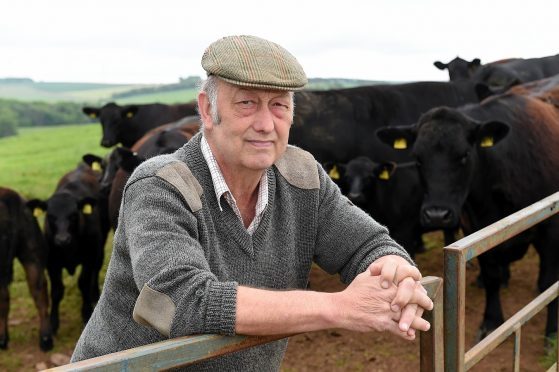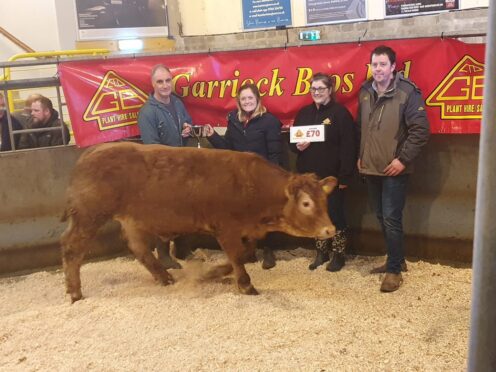Eating quality and consistency are the two main aims at Glenbervie, according to estate manager John Lohoar.
The experienced cattleman joined the enterprise 25 years ago to set up the Angus herd, which now comprises 200 cows.
The herd was founded on females from the Blelack and Newcairnie herds, and the first Angus cow arrived on the farm on October 10, 1992.
“I was working in commercial cattle before I came here but I have been involved with Aberdeen-Angus cattle since I was born,” said Mr Lohoar, who was recruited by current estate owner Alastair Macphie’s late father Stewart.
He said the original aim of the herd was to provide meat for the Macphie business, formerly known as Macphie of Glenbervie.
Macphie makes ingredients used by bakers, pubs, restaurants, hotels, ready-made food firms and caterers. It employs more than 270 people across two sites located in Glenbervie and Tannochside, near Glasgow.
“The whole idea of the herd was to be able to sell a product that’s recognisable and that’s high quality, so that folk would come back for it time and time again,” said Mr Lohoar. “Aberdeen-Angus is probably the most recognised name within all the breeds for meat quality. If you go to any punter and ask ‘what breed would you eat?’ the majority would name Aberdeen-Angus.”
In the early days cattle from the herd supplied meat to a processing plant, on site at Macphie, for sale to high-end restaurants in London.
However, this proved to be a “logistics nightmare”, said Mr Lohoar, and the company switched to supplying a major retailer.
Fast forward 25 years and all Glenbervie cattle are either finished for slaughter at Scotbeef and sold in Marks and Spencer, or sold as breeding females all over the world.
Glenbervie has sold bulling heifers to countries including Romania, Germany, Spain and Estonia.
Males are castrated and finished at under 22 months old with a target carcase weight of 360kg. They are fed on home-grown forage, cereals and some bought-in minerals and protein.
“What we have got to do is try and produce the best quality eating beef that we can with marginal land,” said Mr Lohoar.
The herd used to be split into two groups for calving, however in recent years Mr Lohoar and the team have moved to one block with all cattle calving between April and June.
“We start calving inside but we will end up putting them outside to calf,” said Mr Lohoar.
The herd is closed with the exception of bulls, which are bought in.The five stock bulls currently running with the herd are: Tonley Ramires, which was bought privately from the Wattie family at Mains of Tonley, Alford, for 12,000gn; Blelack Latitude, which was bought from the Massie family at Aboyne at the Stirling Bull Sales in February for 8,000gn; Blelack Lord Heathcliff, which was bought privately in August last year for 5,500gn; Blelack Prince Charlie, bought privately for 5,000gn; and home-bred bull Glenbervie Jacobite Eric.
Everything is housed in the winter, normally between the months of December and April.
Cattle are given a winter ration of ammonia-treated straw, silage and minerals, while fattening beasts are fed silage, barley, minerals, straw and some protein.
Mr Lohoar said: “We try to finish them when everybody else is not producing cattle. We take them right through to about 22-months-old and they are fattened in January and February or June, July and August.”
He takes great pride in producing a consistent product the market wants – in the past five years only around five of the cattle sent from Glenbervie for slaughter have been out of specification.
“If you can give the consumer what they are wanting to buy and it’s a quality product they come back and buy more,” said Mr Lohoar.
“When we were supplying the top restaurants, the biggest complaint we got was that they got inconsistent eating quality in the beef. That’s because of so many different breeds being used and the different ages to kill the animals. It’s just a massive mix. We (industry) are still getting that. At least when you are working with one breed you are starting to be consistent.”
So what is the key to being consistent? And what type of Angus is Mr Lohoar trying to breed?
“What we select on is getting the females right,” said Mr Lohoar. “If you can get the females right, all the steers will tend to follow. We are not looking for any of the extremes. We are looking for a good-sized animal of about 650kg to 750kg liveweight to give us the 360kg dead steer weights. They need to be growthy and milky to produce the next generation.”
Fertility is also key at Glenbervie and Mr Lohoar said all cattle must be easy-calving and they must get in calf every year.
Asides from the cattle, the home farm on the 2,000-acre estate also carries a 500-acre arable enterprise. This year the rotation includes Irina spring barley, Laureate and Concerto malting barley, and Myriad and Horatio winter wheat. About 40 acres of ground is also let out for potatoes.
In total the Glenbervie Estate stretches across 2,000-acres near Stonehaven and it is also home to 400 acres of forestry and two tenant farms.
The estate is participating in this month’s World Angus Forum and it will host an open afternoon to view cattle and the estate’s gardens on Friday, June 30.










